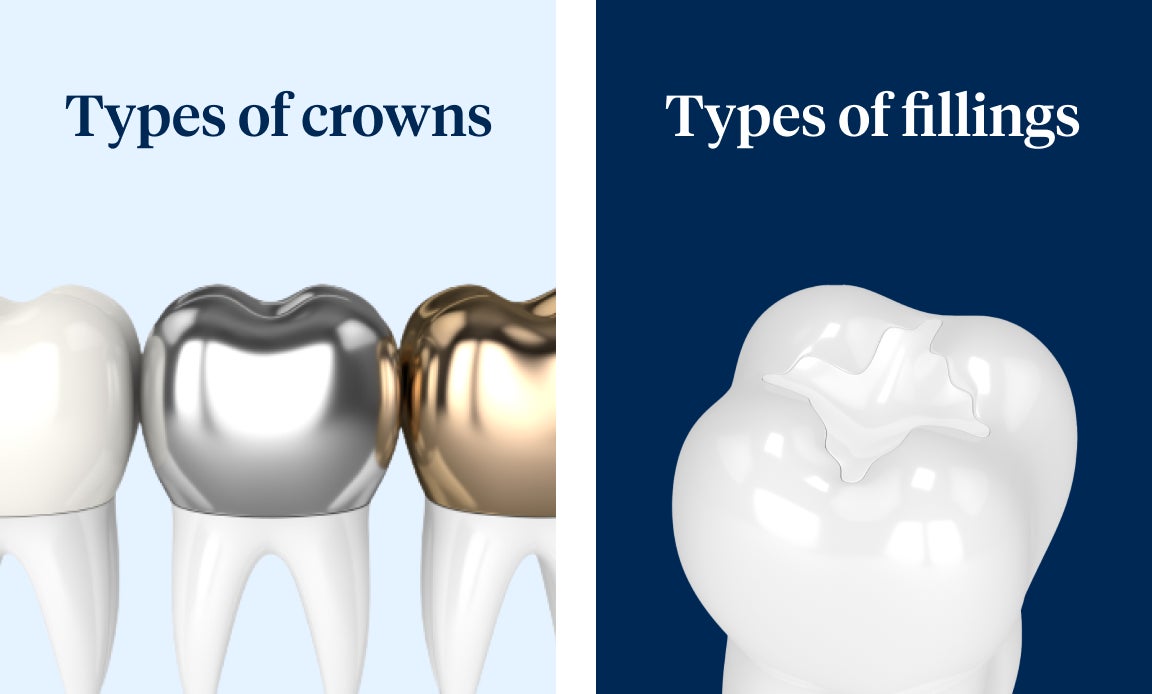Last updated 10.23.2024
Dental crown vs filling
Unsure if a dental crown or filling is right for you? Aspen Dental explores the differences to guide your choice.

Dental crowns and fillings both play vital roles in restorative dentistry, but they serve different purposes and are suitable for various situations. We’ll explore what the benefits and reasons behind each of these are in this blog. And for more detailed information on these dental procedures, explore our pages on dental crowns and dental fillings to see which option might be right for you.

What are dental crowns
Basics of dental crowns
Dental crowns, also known as teeth caps, are custom-made restorations designed to cover and protect a damaged or decayed tooth. Made from materials like porcelain, ceramic, metal, or a combination of these, crowns restore the tooth's shape, strength, and appearance. They are highly compatible with the body's tissues and provide a durable solution for various dental issues.

Who should get dental crowns?
Dental crowns offer a long-lasting solution, perfect for various dental needs. They are ideal in situations such as:
Protecting a fractured or broken tooth
Following a root canal treatment
Covering a dental implant
Restoring a decayed tooth
Enhancing the appearance of a discolored or misshapen tooth

Basics of dental fillings
What are dental fillings?
Dental fillings offer a simple and affordable solution for repairing minor tooth damage, such as small cavities. During the procedure, your Aspen Dental dentist will remove the decayed portion of your tooth and fill it with a material like composite resin. This process not only restores your tooth's function but also helps prevent further decay, keeping your smile healthy and strong.

Who should get dental fillings?
Dental fillings are the best option for:
Small cavities
Large cavities
Repairing chipped teeth
Dental crowns vs. fillings: understanding the key differences
After understanding what dental crowns and fillings are, it’s important to compare them based on several factors to determine which option might be best for your specific dental needs.

Material
Crowns are made from durable materials like porcelain, ceramic, metal, or a combination, while fillings are almost always made from composite resin.
Procedure
The crown placement procedure involves multiple steps, including tooth preparation, impression taking, and fitting the custom-made crown. This requires two visits. In contrast, a tooth filling is usually a quicker process, often completed in a single visit.
Cost
Crowns are generally more expensive than fillings due to the complexity of the procedure, the use of a professional dental laboratory to make the crown and the materials used. For more detailed cost information, visit our pages on dental crowns cost and dental fillings cost.
Lifespan
Crowns typically last longer than fillings, often up to 15 years or more with proper care. Fillings, depending on the material, may need to be replaced every 5 to 10 years.
Appearance
Crowns offer a natural and aesthetically pleasing look, especially when made from porcelain or ceramic. Fillings, particularly composite resin fillings, can also be color-matched to your teeth and offer a seamless appearance.
Extent of damage
Crowns are suitable for extensive tooth damage, while fillings are ideal for minor repairs and small cavities.
What is the right option?
Your dentist will determine if a root canal or a tooth filling is right for you. Fillings are ideal for minor decay, while root canals are necessary for severe infections. It's essential to evaluate your current dental situation and consult with your Aspen Dental care team to make the best decision for your oral health.

Final thoughts
Clearly understanding the differences between dental crowns and fillings and evaluating your specific dental situation is crucial for making the right choice. Consulting with your Aspen Dental dentist will provide you with more personalized insights and help you make a well-informed decision. For further assistance, schedule an appointment with Aspen Dental.
Schedule appointment>



